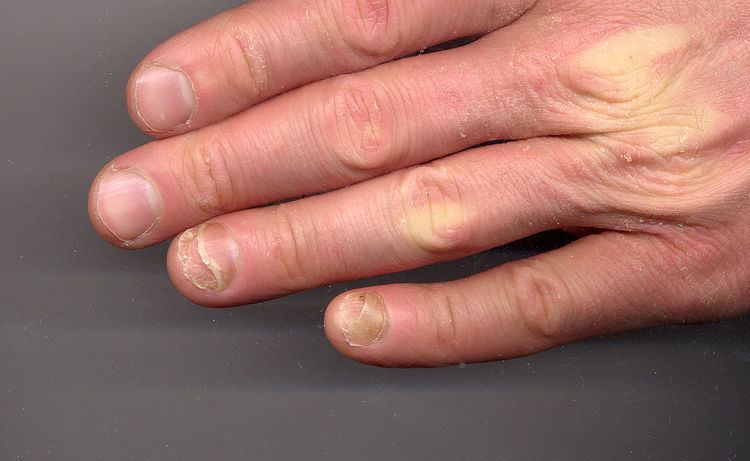Specialty dermatology ICD-9-CM 703.8 MeSH D054039 | ICD-10 L60.1 DiseasesDB 9236 | |
 | ||
Onycholysis /ˌɒnᵻˈkɒlɪsɪs/ is a common medical condition characterized by the painless detachment of the nail from the nail bed, usually starting at the tip and/or sides. On the hands, it occurs particularly on the ring finger but can occur on any of the fingernails. It may also happen to toenails.
Contents
Onycholysis can occur in many conditions, including psoriasis. In thyrotoxicosis it is thought to be due to sympathetic overactivity. It may also be seen in infections or trauma.
Etymology
Onycho-, from Ancient Greek ónuks, meaning nail, and Ancient Greek lúsis, meaning a loosening.
Causes
Treatment
Most instances of onycholysis without a clear cause will heal spontaneously within a few weeks. The most commonly recommended treatment is to keep the nail dry as much as possible and allow the nail to slowly reattach. Trimming away as much loose nail as can be done comfortably will prevent the nail from being pried upwards. Cleaning under the nail is not recommended as this only serves to separate the nail further. Bandages are also to be avoided. When kept dry and away from further trauma, the nail will reattach from the base upward (i.e., from proximal to distal).
If the underlying cause of the condition is not found and the nail continues to detach despite conservative treatment, the nail bed may begin to form a granular layer of abnormal cells on its surface. After six months of detachment, this layer is likely to prevent the adhesion of any new nail tissue, possibly leading to permanent deformity.
